This content originally appeared on Bits and Pieces - Medium and was authored by Jonathan Saring
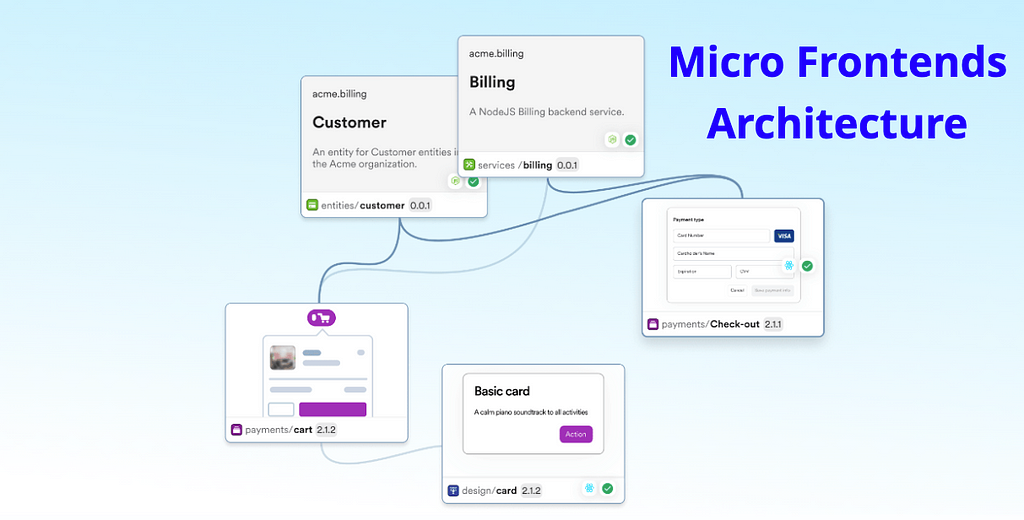
Micro frontends are fundamentally changing how we build and scale frontend. By breaking down monolithic frontends into smaller, more manageable pieces, teams can develop, deploy, and update frontend components independently, which enhances scalability and flexibility.
As enterprise applications become complex, adopting micro frontends is critical for maintaining agility and accelerating development cycles.
In this guide, we’ll explore the key requirements for successfully implementing micro frontends in 2024. We’ll also delve into how Bit and Webpack Module Federation can help meet these requirements and scale micro frontend architectures across large organizations.
This guide will walk you through the foundations of building a composable, scalable, and performant micro frontend architecture in your organization, including collaboartion and updates across many applications.
Before reading, feel free to go ahead and watch this coding demo:
And try out this tutorial ✍️:
Micro Frontends: A Practical Step-by-Step Guide
Let’s dive in, and feel free to add your ideas and suggestions below ✏️
Key Requirements for Micro Frontend Architecture

To successfully implement micro frontends in an enterprise environment, several critical requirements must be met. Let’s explore each requirement in detail and examine how Bit addresses them.
1. Decoupled Development
Decoupled development in micro frontend architecture allows each micro frontend to be developed, deployed, and maintained independently. Each one, representing a distinct feature, can use its own tech stack, release schedule, and processes. This autonomy reduces team dependencies, enabling faster innovation and iteration.
In large enterprises, frontends often become monolithic and challenging to manage, where changes can impact the entire system, slowing development and increasing risks. Decoupled development breaks the frontend into manageable pieces, letting teams:
- Innovate Faster: Choose optimal tools and frameworks, speeding up development.
- Reduce Risk: Isolate changes to minimize impact on the broader application.
- Scale Efficiently: Independently scale each micro frontend, supporting organic growth.
Bit provides an enterprise-grade platform for implementing decoupled development in micro frontends. Here’s how Bit facilitates this process:
- It enables developers to encapsulate frontend features as individual, independently developed and versioned components. This isolation allows teams to update and release new versions without affecting other parts of the application. For instance, one team can update a React-based micro frontend while another simultaneously works on an Angular component, with both managed independently.
Learn more:
- Example: A React component for a user profile page can be developed in isolation within Bit’s environment. It can be versioned, tested, and deployed independently of the rest of the application, ensuring that any updates to this component don’t disrupt other micro frontends.
2. Custom Development Environments: Bit supports custom development environments tailored to different technology stacks.
Multiple Environments can be used in the same “monorepo” and even reused across repositories.
Teams can set up specific environments for React, Angular, Vue.js, or any other framework. These environments include all the necessary tools, such as linters, compilers, and testing frameworks, ensuring that each micro frontend is developed under consistent conditions. Learn more:
- Example: A team might use Bit to set up a custom React environment with ESLint and Jest for testing, while another team sets up an Angular environment with Karma for unit testing. These environments ensure that the development, testing, and building processes are standardized and streamlined within each micro frontend’s context.
4. Capsules for Isolated Builds: Bit’s Capsule technology allows components to be built in complete isolation from the rest of the codebase. This isolation ensures the build is executed and that all dependencies are correctly managed, preventing global scope issues and making it easier to catch and fix bugs early in the process. Capsules provide developers with a reliable development and testing ground before deployment.
2. Version Control and Dependency Management
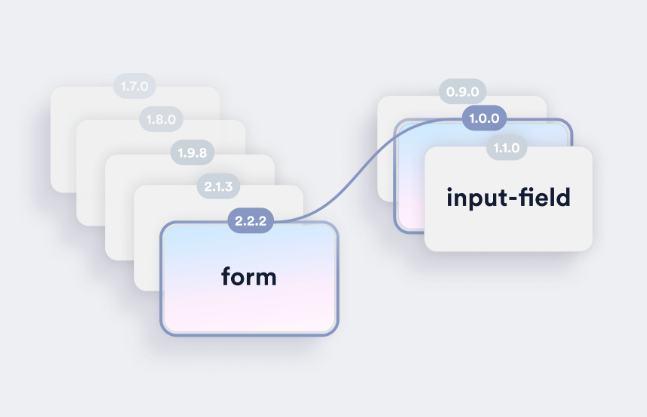
Version control and dependency management are crucial aspects of micro frontend architecture. In a micro frontend setup, each frontend module or component is developed, versioned, and maintained independently.
This independence means that each module can evolve at its own pace, with its specific dependencies and versioning system.
Per-component version control ensures that updates to a micro frontend do not inadvertently break other parts of the application, while effective dependency management prevents conflicts and ensures that each module can function as intended in the larger ecosystem.
In large-scale applications, managing dependencies and versions becomes increasingly complex as more micro frontends are introduced.
Without a robust system, it’s easy for dependency conflicts to arise, leading to issues like duplicate libraries, version mismatches, or even application crashes. Proper version control and dependency management ensure that:
- Stability is Maintained: Updates to one micro frontend don’t break others, maintaining the overall stability of the application.
- Dependencies are Consistent: Each micro frontend uses the correct versions of shared libraries, avoiding conflicts and redundancy.
- Deployment Flexibility: Teams can update or roll back specific micro frontends without affecting the entire application, enabling more flexible and responsive deployment strategies.
Bit provides a comprehensive solution for version control and dependency management in micro frontend architectures. Here’s how it supports these processes:
Independent Versioning
Bit enables each component or micro frontend to be versioned independently (using semver rules). This allows teams to mix and match components, update or roll back specific components without impacting others, enabling incremental changes and releases for micro frontends.
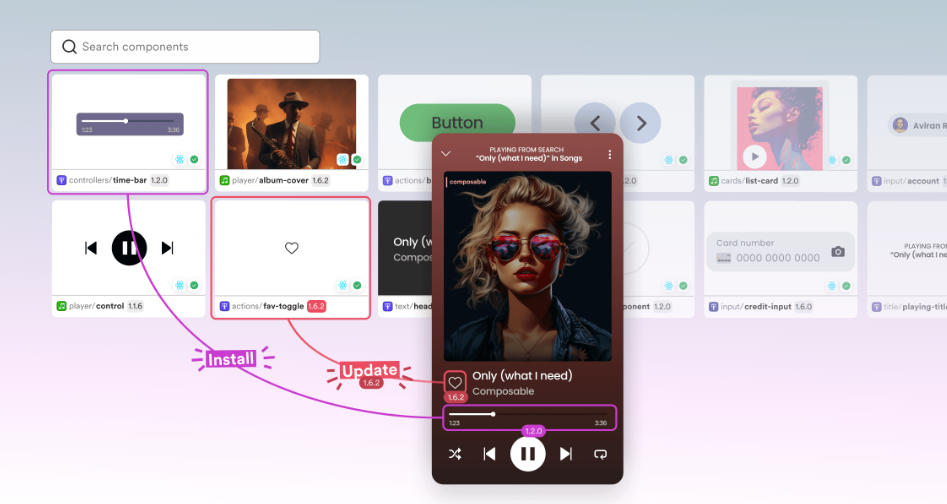
Moreover, you can compare changes between component versions, and not just code, but also previews, docs, tests, dependencies and more:
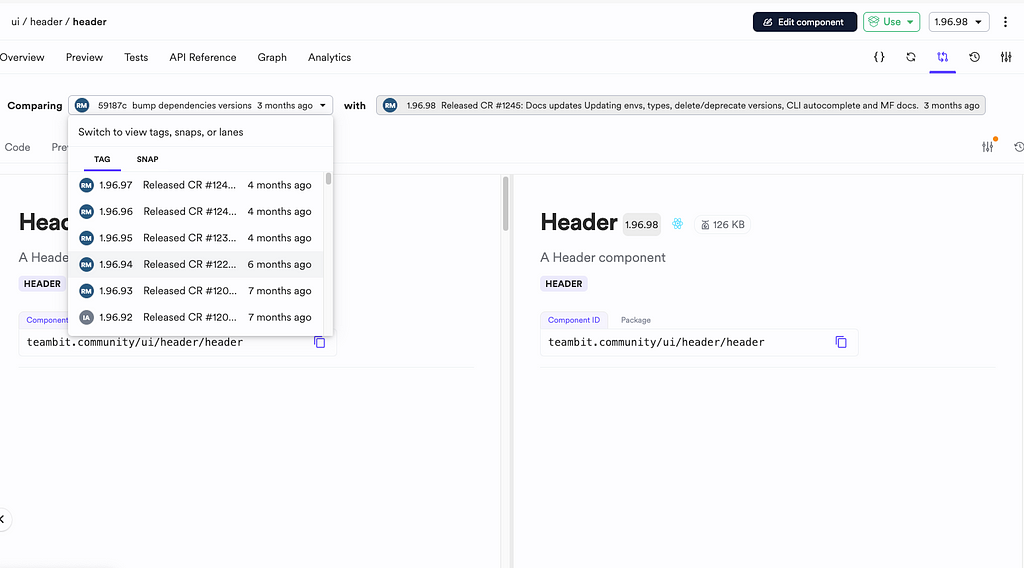
Every change in a component is tracked and managed within Bit, providing a clear history of versions and changes. Tagging a component will apply a version, and bumping a version will drive Bit to prompt you if there are other components that also require a version bump as a result. Learn:
- Example: A team might update a login component to improve security. With Bit, they can release a new version of this component while other parts of the application continue to use older, stable versions. If any issues arise, it’s easy to revert to a previous version without affecting the rest of the system.
Automated Dependency Management
This is where Bit is a real game changer.
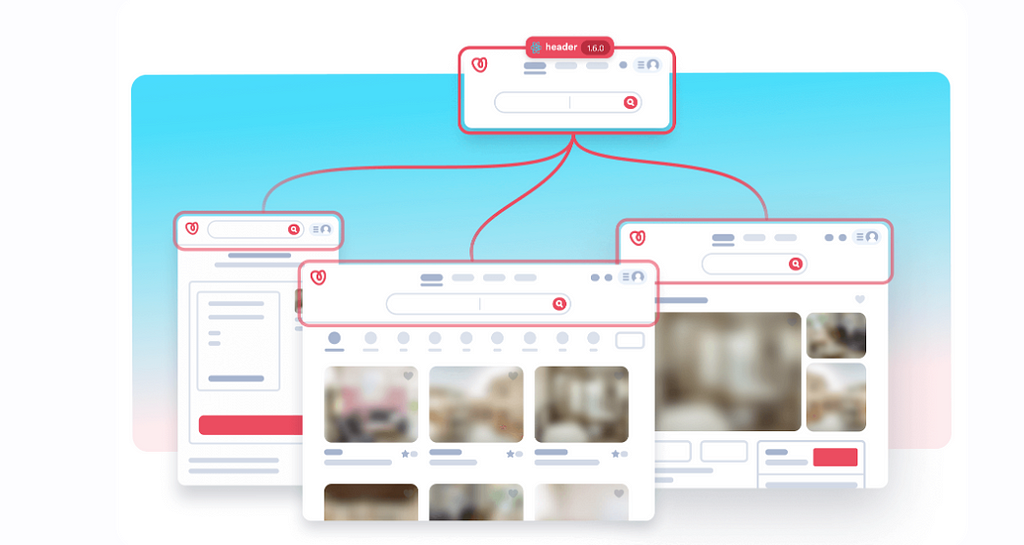
Bit automatically defines and manages the dependencies of each component. When a component is created or updated, Bit resolves and installs all necessary dependencies, ensuring that each micro frontend has everything it needs to function correctly.
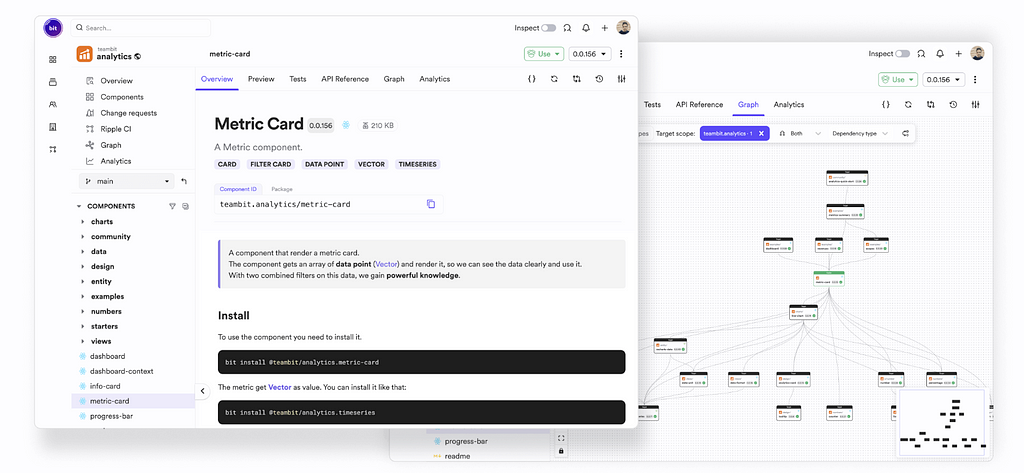
This process helps prevent issues like dependency conflicts or missing libraries, which are common in complex applications with monorepos, micro frontends and shared components. Here’s a VIDEO DEMO by PNPM’s author.
- Example: Suppose a micro frontend relies on a specific version of a library like lodash. Bit will ensure that the correct version is installed and that other micro frontends using different versions of lodash do not interfere with it. This isolation prevents conflicts and ensures that each micro frontend remains stable and functional.
- Shared Dependencies: Bit also automates the management of shared dependencies across micro frontends. When multiple micro frontends use the same library or component, Bit helps to manage these shared dependencies to avoid duplication and reduce bundle size. Shared dependencies are consistent across the application while allowing individual micro frontends to update independently.
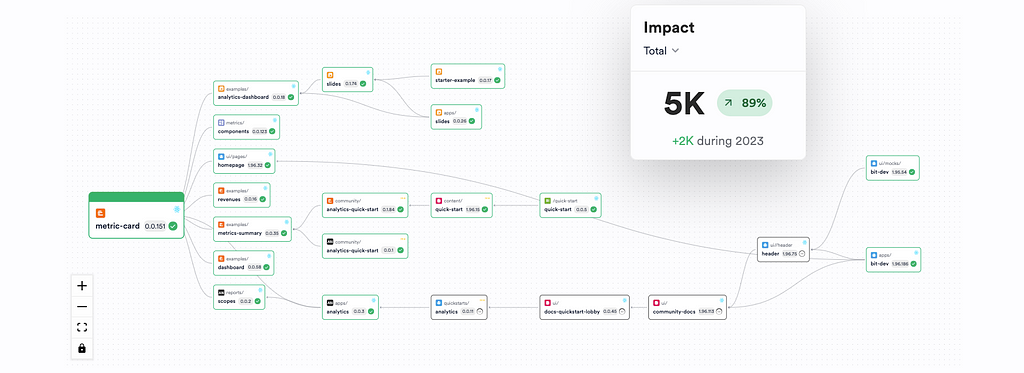
- Example: A design system or a utility library used by multiple micro frontends can be shared as a Bit component. This shared component is versioned and maintained in a central repository, making it easy for teams to pull the latest version or revert to previous versions as needed.
Integrating with CI/CD Pipelines
Bit integrates seamlessly with CI/CD pipelines, automating the process of testing, building, and deploying components as they are updated. This integration ensures that every version of a component is thoroughly tested before it goes live, reducing the risk of introducing bugs or breaking changes into the production environment.
You can even automate PR updates to your GitHub repositories:
- Example: When a new version of a micro frontend is pushed to Bit, the CI/CD pipeline automatically triggers tests, builds the component, and prepares it for deployment. If all checks pass, the new version is tagged and released; if not, the deployment is halted, preventing potential issues from reaching users.
3. Runtime vs Build-Time Integrations and Updates
The decision between runtime and build-time integrations impacts the flexibility and scalability of micro frontend architectures. Runtime integration allows for dynamic composition and updates, while build-time integration involves compiling everything into a single bundle, which can limit flexibility but offers high performance and a good dev experience.
As each component is a standalone package or module, with its own version, it becomes possible to update specific components (and their impacted dependents) without having to update the rest of the project.

Bit supports both types of integrations and lets you choose which one is right for you. It plays natively with Module-Federation, as well as every package manager or registry.
For example, here are a couple of demos of integrating and updating Bit components using Module-Federation:
And a dive into their deployments in that setting with module federation:
At the same time, every component exported to bit.cloud is already a package — it happens automatically as you tag and export the component. Meaning, you can install it using any package manager or registry (including JFrog Artifactory), and you can find this pane on every component page under the “use” tab:
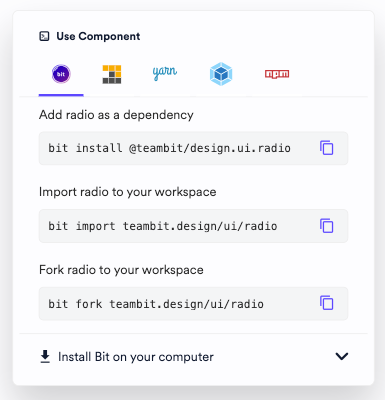
Independent Deployments
Micro frontends should be deployable independently, allowing different parts of the application to evolve and be released at their own pace without requiring synchronization with other components.
Bit’s modular architecture allows each component or micro frontend to be deployed independently. Bit integrates seamlessly with Webpack Module Federation, enabling components to be loaded on demand at runtime. This decouples the deployment process from the rest of the application, allowing for rapid, autonomous deployments.
6. Shared Micro Frontends via Central Platform
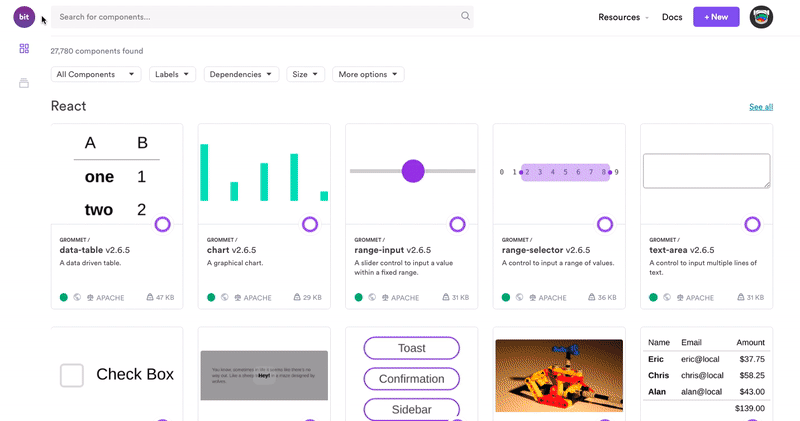
6.1 Central platform
Bit.cloud is a central platform for shared components (e.g. micro frontends). It offers cloud hosting, private cloud, and local server based versions. Bit cloud is an end-to-end platform for component-driven development, which enables a streamlined and complete workflow for creating, sharing, discovering, consuming, changing and upating components. This is a critical part of successfully adopting micro frontends at an organizational environment and scale. It can be integrated and connected with your tools and workflows, like GitHub or Artifactory, as well as Figma and even your CI/CD tools.
Your micro frontends can be hosted in your private account, in your organization account, and split into “Scopes” that serve as collections of components with common themes, domains of ownership.
Go ahead and check it out:
Bit. Composable software platform.
6.2 Discovery for micro frontends
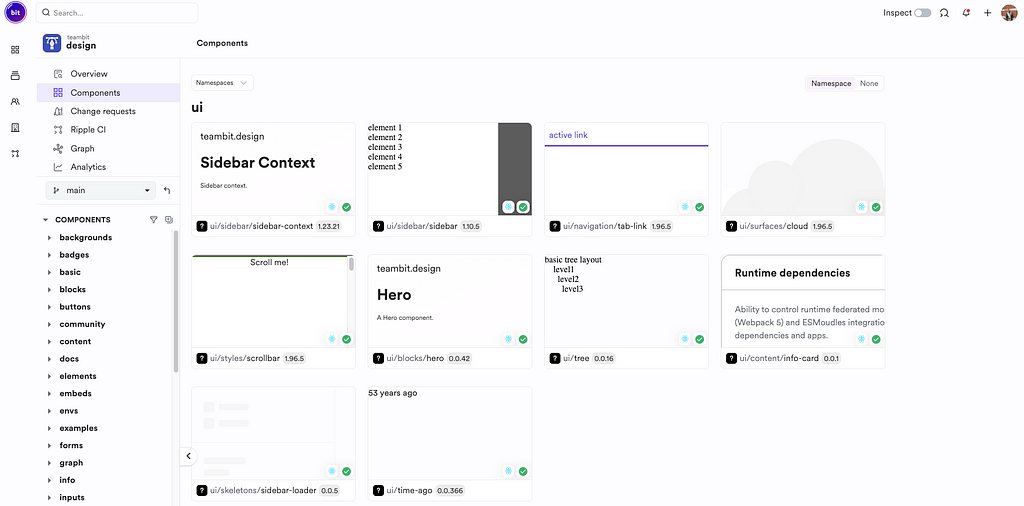
Bit Cloud offers a robust platform for discovering shared micro frontend components, making it easy for teams to find, understand, and choose the best components for their projects. It provides advanced search capabilities, allowing users to filter components based on specific criteria such as tags, dependencies, and versions. This helps developers quickly locate the exact component they need.
In addition to search functionality, Bit Cloud enhances component discovery with visual examples and auto-generated documentation. Each component’s page features detailed documentation, including usage instructions, dependency maps, and visual compositions that show the component in various states and contexts. These compositions simulate the component’s behavior, helping developers and non-developers alike (such as designers) to understand how the component works and how it can be integrated into different projects.
6.3 Analytics for status, usage and adoption
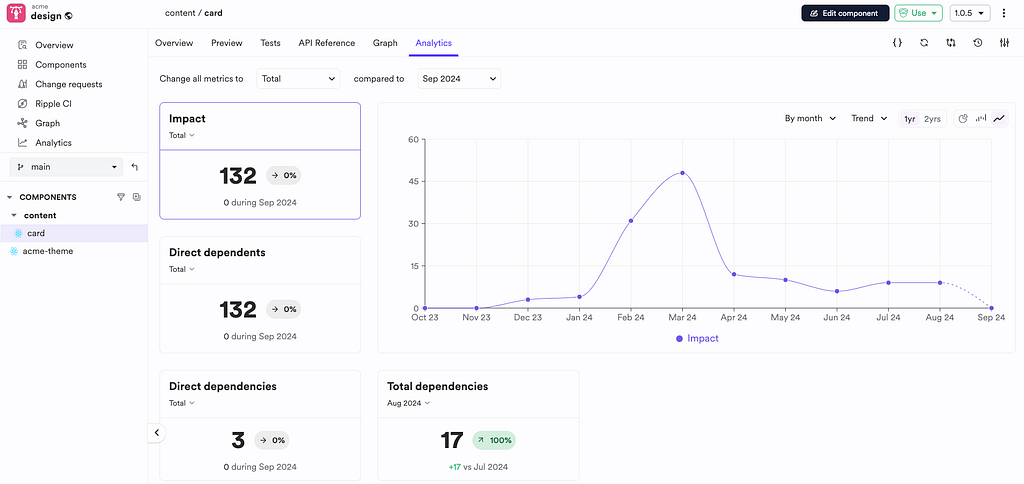
One of the most important aspects of scaling development with shared micro frontends or any other types of components is the abilty to track their usage, adoption, tech-stacks, status and every other important parameter that helps to govern and manage these building blocks.
On Bit.Cloud you can view each component’s (or Scope’s) direct and indirect dependencies and dependents, usage in different projects, version updates, technologies used and more.
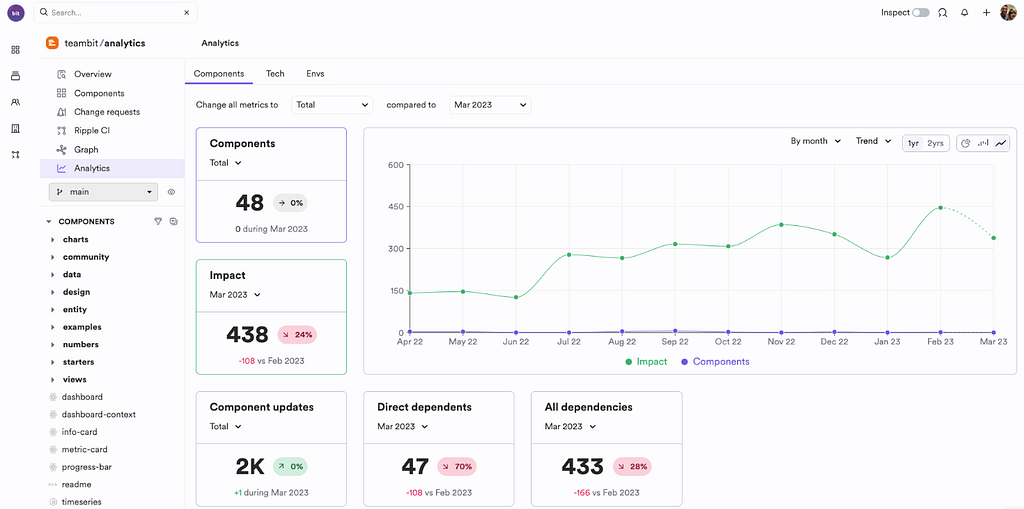
7. Collaborative Development

Effective micro frontend architectures require collaboration across teams, and also inside cross-functional teams. Builders need to be able to work together seamlessly, even when developing different parts of the application, while working together to plan, review and release.
Bit is designed to allow collaboration.
For example, new versions for components can be suggested via “change-requests”, where the reviewing team members can see code changes, visual previews, changes to tests, dependencies and much more. They can discuss and approve these changes directly in the change request screen.
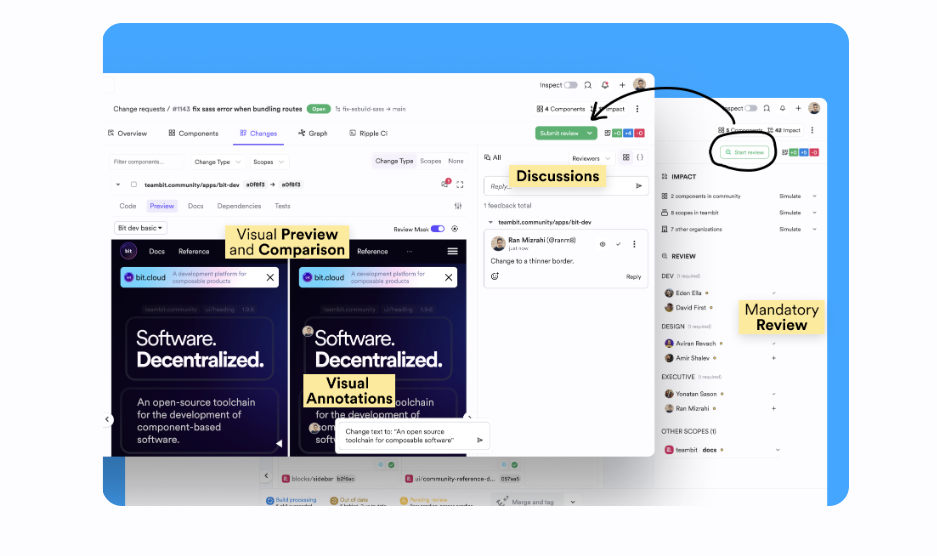
Moreover, components can be easily imported into your local workspace for editing and changes, which makes it very easy to collaborate on components, suggest changes, deliver updates, and stay in sync.
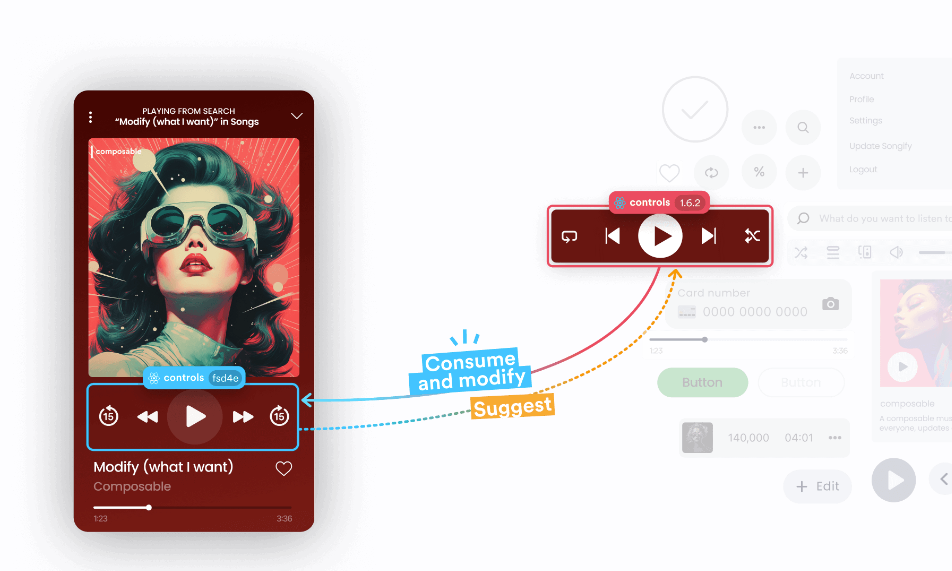
This collaborative environment accelerates development and ensures that all teams are aligned, tech is standardized, and UX/UI remains consistent.
8. Autonomous Teams
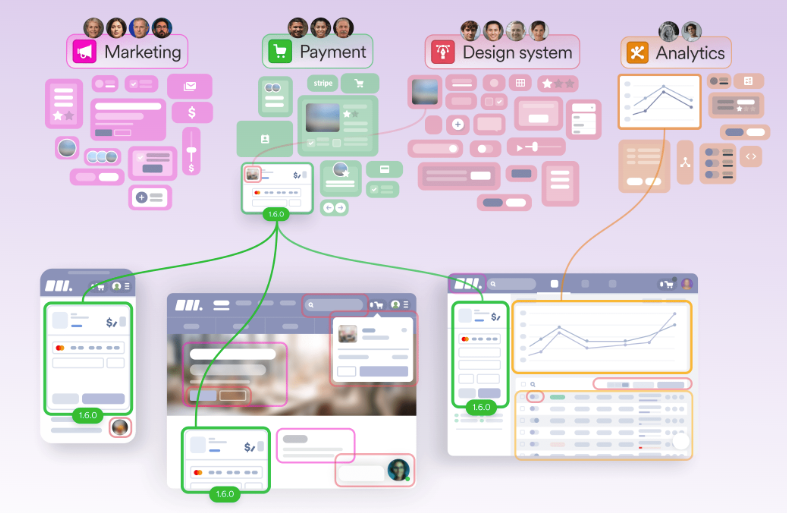
Teams working on different micro frontends should operate autonomously, with full control over their respective domains. This autonomy is crucial for fostering innovation and reducing bottlenecks in the development process.
Bit’s platform supports autonomous teams by providing them with the tools to develop, test, and deploy their components independently. Each team can manage their own workflows, from development to deployment, without needing to coordinate with other teams. This autonomy is enhanced by Bit’s support for independent versioning, deployment, and runtime integration, allowing teams to move fast and innovate freely.
9. Multiple Technology Stacks
Micro frontends are particularly powerful in organizations where different teams prefer using different technology stacks. This flexibility allows each team to select the best tools and frameworks for the specific features they are developing. For example, one team might use React for a user dashboard, another might opt for Angular for handling complex forms, while yet another team could leverage Vue.js for lightweight, fast-loading components like navigation bars.
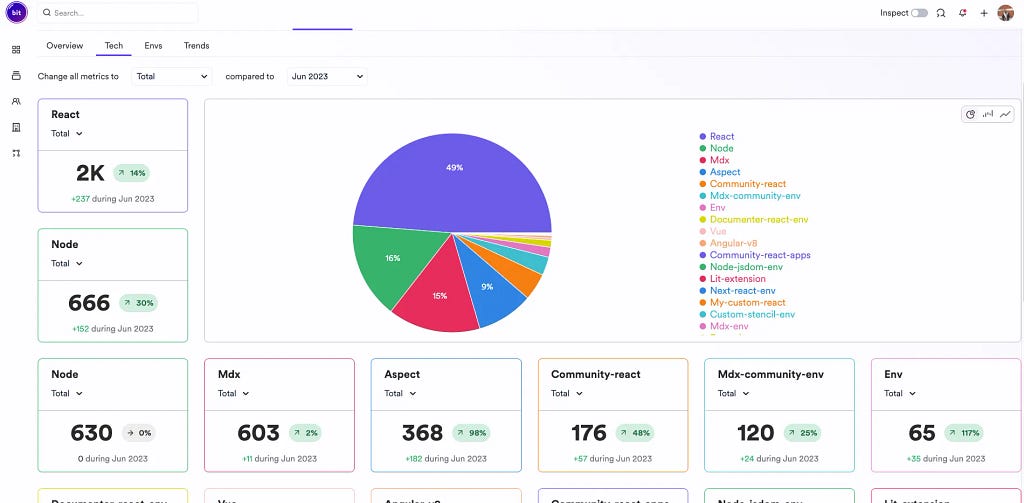
Bit plays a crucial role in managing these diverse stacks through its Component Environments. Bit environments are extensions that configure and manage the development tools and workflows specific to each framework or technology stack. When working in a Bit-managed workspace, teams can create custom environments for React, Angular, Vue.js, or any other technology stack they are using. These environments ensure that each component is isolated and developed in a consistent environment, regardless of the underlying technology.
For instance, a React component environment in Bit might include configurations for ESLint, Jest, and Webpack, while an Angular environment could set up TypeScript, Karma, and Angular CLI. This allows each team to focus on development without worrying about cross-stack conflicts, as Bit handles the integration and ensures that each component is compatible when combined into a larger application.
Furthermore, Bit environments support Capsules, which create isolated development environments for components. This means that each component can be developed, tested, and built in complete isolation from the rest of the codebase, ensuring that issues like dependency conflicts or global state leaks are caught early(
10. Application Shell
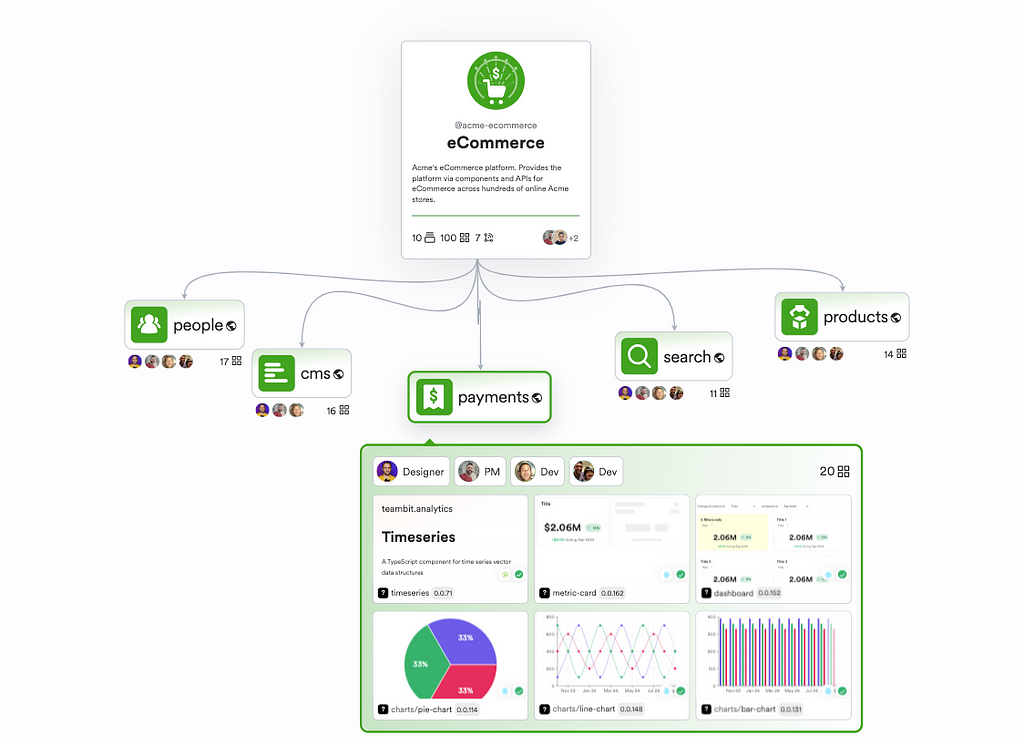
An App Shell is a static framework that loads first and provides the core structure of a web app, including shared UI elements like headers and navigation bars. In a micro frontend architecture, the app shell ensures a consistent user interface while dynamically loading micro frontends.
The app shell serves as a stable base, managing the routing and state while micro frontends are loaded independently. This separation allows each micro frontend to be developed and deployed without impacting the overall application.
- Independent Development: Bit enables the creation of both app shells and micro frontends as separate components, allowing them to be developed, versioned, and deployed independently.
- Dynamic Integration: Using Webpack’s Module Federation, Bit allows micro frontends to be dynamically loaded into the app shell, ensuring smooth integration at runtime.
- Centralized Management: Bit Cloud centralizes the storage and management of app shells and micro frontends, making it easy to discover, update, and share components across the organization(
In essence, Bit supports the seamless integration and independent management of app shells and micro frontends, ensuring consistency and flexibility in complex web applications. Here’s an example:
Application Shell for React Micro Frontends
Conclusion
Micro frontends are a powerful architectural approach for managing the complexity of modern enterprise applications. By meeting the key requirements of decoupled development, independent versioning, incremental updates, independent deployments, runtime integration, shared components, collaborative development, and autonomous teams, organizations can achieve a highly modular, scalable frontend architecture. Bit and Webpack Module Federation offer a robust set of tools to support these goals, empowering teams to innovate faster and deliver exceptional user experiences in a rapidly evolving digital landscape.
Micro Frontend Architecture: A Guide was originally published in Bits and Pieces on Medium, where people are continuing the conversation by highlighting and responding to this story.
This content originally appeared on Bits and Pieces - Medium and was authored by Jonathan Saring
Jonathan Saring | Sciencx (2024-09-05T09:06:01+00:00) Micro Frontend Architecture: A Guide. Retrieved from https://www.scien.cx/2024/09/05/micro-frontend-architecture-a-guide/
Please log in to upload a file.
There are no updates yet.
Click the Upload button above to add an update.
